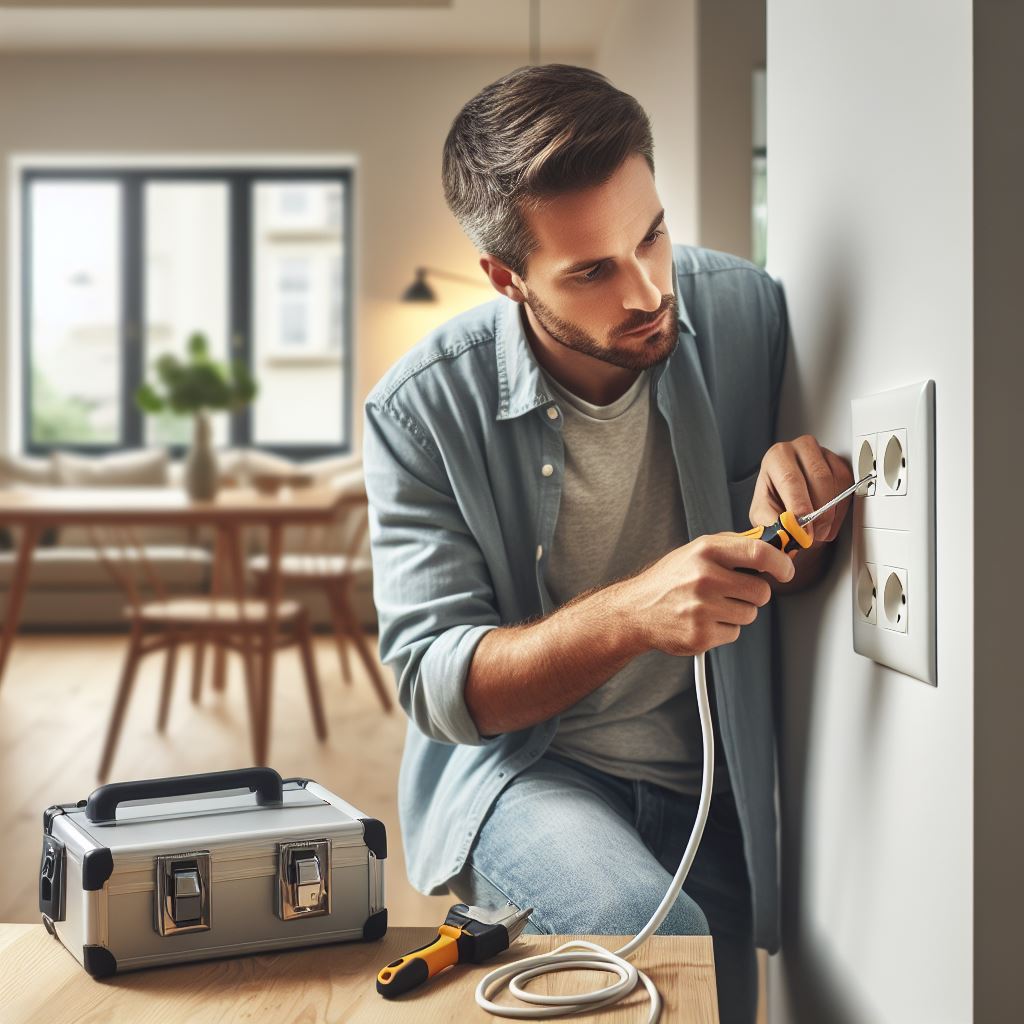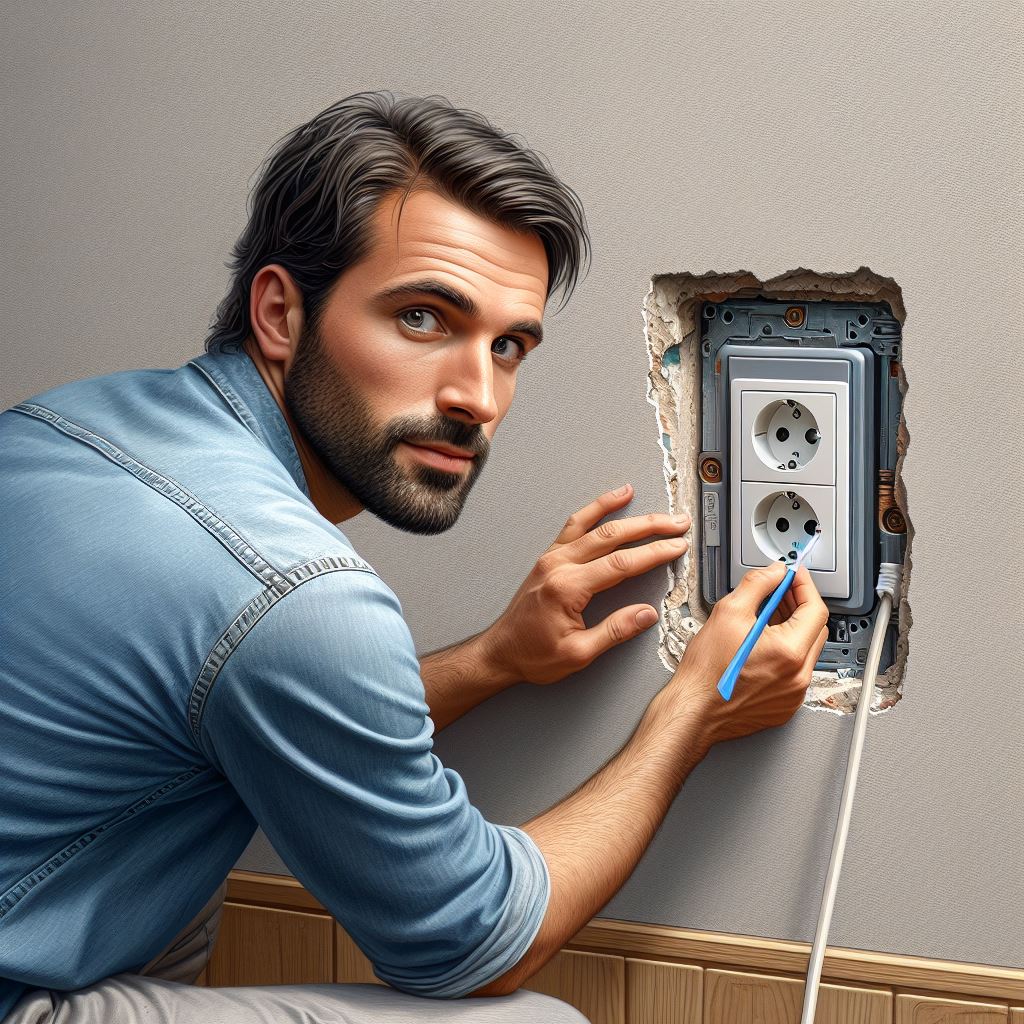Welcome to the world of room improvement, where adding an extra outlet can be both a practical necessity and a game changer in how you use your space. Whether you’re looking to eliminate the spiderweb of extension cords or preparing a nook for that new tech gadget, adding an outlet is a smart move. But, before we roll up our sleeves, a word to the wise: dealing with electricity requires caution and respect. It’s essential to have a clear understanding of electrical basics for your safety and the integrity of your home’s electrical system.

Understanding Your Current Electrical System
- Assessing Your Home’s Electrical Capacity: Before diving into this project, it’s important to gauge the current capacity of your electrical system. It’s akin to understanding the load capacity of a bridge you’re planning to cross. Overburdening an electrical system is not just inefficient, it’s hazardous. Check your service panel to know whether you have a 100-amp or 200-amp service. This knowledge is crucial as it determines how much more load you can safely add.
- Identifying the Type of Wiring System: Your house’s wiring is its electrical lifeline. Older homes may feature knob-and-tube or aluminum wiring, while newer constructions usually have copper wiring. Each type has its own set of rules and compatibility when it comes to extensions and modifications. It’s imperative to identify the type you have, as this will influence your material choices and installation approach.
- Recognizing the Limits of Your Electrical Panel: Understanding your electrical panel’s capacity is like knowing the limits of what you can safely carry without straining your back. Each circuit breaker is rated for a specific load, and it’s vital to ensure that adding another outlet doesn’t overload your existing circuit. It’s not just about adding an outlet, it’s about integrating it safely into your home’s electrical ecosystem.
Tools and Materials Needed
Now, let’s talk about the tools of the trade and the materials you’ll need. This is where your project begins to take shape.
Tools:
- Wire Strippers: Essential for cleanly stripping wire insulation without damaging the wire.
- Drill: For creating openings in the wall for your new outlet box.
- Screwdrivers: Both flat-head and Phillips, for various screws you’ll encounter.
- Voltage Tester: A non-negotiable tool to ensure wires are not live during work.
- Fish Tape: Ideal for pulling wire through confined spaces in walls.
- Pliers: Necessary for gripping and twisting wires securely.
- Utility Knife: For precision cuts on wire insulation and wall materials.
- Safety Gear: Gloves and safety goggles are indispensable for personal protection.
Materials:
- Electrical Boxes: The housing for your new outlet.
- Outlet Receptacles: The actual outlets where you’ll plug in devices.
- Wire Nuts: For securing wire connections reliably.
- Wires: Correct gauge is critical – typically 14-gauge for 15-amp circuits and 12-gauge for 20-amp circuits.
- Cable Clamps: To securely anchor wires within boxes.
- Wall Plate: Adds a clean, finished look to your installation.
Equipped with the right tools and materials, you’re now ready to embark on this rewarding project. Remember, the key to a successful installation is not just in following these steps, but understanding them and knowing why each one matters. Let’s move forward with confidence and safety at the forefront.

Planning and Preparation
When preparing to add an outlet, thoughtful planning is crucial. Here are some key considerations:
- Choosing the right location for the new outlet: This decision should balance practicality and safety. Look for a spot that enhances the room’s functionality without being obstructed by furniture or posing a trip hazard with cords. It’s equally important to consider the ease with which you can run wiring to this new location. Avoid areas where you’d have to drill through structural elements or encounter other obstructions.
- Importance of turning off power and verifying it’s off: This is an absolute must for your safety. Cutting off power to the work area prevents the risk of electric shock. Always flip off the appropriate circuit breaker and use a voltage tester on the wires you’ll be working with to confirm they are indeed de-energized. It’s a simple step that ensures a safe working environment.
- Tips for creating a safe working environment: Organize your workspace to prevent accidents. Clear away any unnecessary clutter, ensure adequate lighting, and keep your tools within easy reach. Personal Protective Equipment (PPE) like safety goggles and gloves are non-negotiable – they protect you from potential harm during the project.
Step-by-Step Guide to Adding an Outlet
- Cutting the Hole: Accuracy is key here. Begin by using a stud finder to avoid cutting into any studs. Mark the dimensions of your outlet box precisely. For cutting, you can use a drywall saw for manual control or a rotary tool for a cleaner cut. Aim for a snug fit, the outlet box should fit firmly without gaps.
- Running the Wire: The process of routing the wire from your power source to the new outlet is a critical step. If you’re connecting to an existing circuit, ensure it can accommodate the added load. Use fish tape to guide the wire through walls, taking care to avoid sharp bends that could damage the wire.
- Connecting the Wires: This step requires attention to detail. Strip the wires without damaging the copper, and use the appropriate wire nuts for a secure connection. Connect the wires to the outlet terminals: black (hot) wire to the brass screw, white (neutral) wire to the silver screw, and green or bare (ground) wire to the green screw.
- Installing the Outlet: Gently fold the wires into the box and secure the outlet. Ensure the outlet is level and flush with the wall surface. If it’s protruding or recessed, adjust the box depth accordingly.
- Testing and Troubleshooting: Once everything is installed, restore power and test the outlet with a plug-in tester or a simple device like a lamp. If the outlet doesn’t work, recheck your connections. Often, the issue is a loose wire or a connection made to the wrong terminal.
Safety Tips and Best Practices
In the realm of home renovation, particularly with electrical work, safety is paramount. It’s not just about following steps, it’s about understanding and respecting the inherent risks.
- Emphasizing the Importance of Adhering to Safety Standards: Safety in electrical work cannot be overstated. Personal Protective Equipment (PPE) is a must – this includes safety goggles and insulated gloves as a bare minimum. It’s not just about donning gear, it’s about creating a culture of safety in every step of your work.
- Highlighting Common Mistakes and How to Avoid Them: Overconfidence can lead to serious mistakes in home electrical projects. A common error is assuming the power is off without checking. Always use a voltage tester to confirm. Be aware of the location of water pipes and air ducts when drilling – hitting one inadvertently can lead to costly repairs. And remember, testing your work is not just a step, it’s a critical practice to ensure safety and functionality.
FAQ Section
Never attempt to add an outlet with the power on. Working with live electricity is extremely dangerous and can result in severe injury or worse. Safety in electrical work is about eliminating risks, and turning off the power is the first and most crucial step in this process.
Assessing your panel’s capacity is crucial. Most homes are equipped with either 100-amp or 200-amp service. To determine if your panel can handle an additional outlet, calculate the existing load and compare it to your panel’s capacity. If in doubt, consult an electrician. Overloading a panel can lead to serious hazards.
A GFCI (Ground Fault Circuit Interrupter) outlet is a safety device designed to protect against electrical shock. These outlets are essential in areas exposed to moisture, such as bathrooms and kitchens. They monitor the flow of electricity and can shut off the power when a fault is detected, whereas standard outlets do not provide this level of protection.
While it might be tempting to add an outlet just about anywhere, it’s important to consider structural and safety factors. Avoid exterior walls that tend to have more insulation and potential moisture issues. Interior walls, especially those without plumbing or ductwork, are usually safer choices. Always use a stud finder to avoid drilling into studs or hidden utilities.
In most cases, yes. Electrical work is governed by local building codes, which often require permits for such modifications. This isn’t bureaucracy, it’s a safety measure to ensure work is done correctly and safely. Always check with your local building authority before starting your project.
